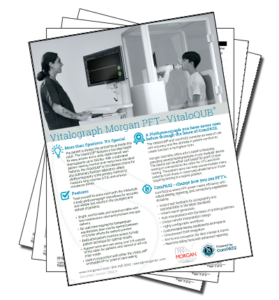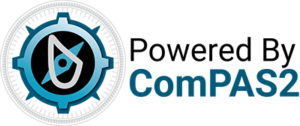Vitalograph Morgan VitaloQUB
More than spacious.
It's special.
Introducing the newest member of the Vitalograph Morgan family with exceptional style, accuracy, and capability. The VitaloQUB Body Plethysmograph cabin features a low step height for easy access and a wide stable bench seat that supports up to 550 lbs. With a dedicated patient viewing monitor and many more standard features, the VitaloQUB is the clearest choice for your PFT lab.
The Pinnacle of Pulmonary Function Testing
The VitaloQUB provides uncompromising style, accuracy, and capability including full Body Plethysmography, Diffusing Capacity, and Spirometry testing. Unique customer support and collaboration give the VitaloQUB with ComPAS2 PFT software the edge as your ambitious partner. It must be seen to be believed, so click to see more!
Product Features
This is only the tip of the iceberg! VitaloQUB is powered by ComPAS2 – a quantum leap in pulmonary function testing software.
Testing Capabilities
Forced Vital Capacity
(FVC)
The forced vital capacity (FVC) measurement is the most common spirometry test. It shows the amount of air a person can forcefully and quickly exhale after taking a deep breath.
Slow Vital Capacity
(SVC)
Slow Vital Capacity (SVC) measures various lung capacities and volume segments, such as vital capacity, inspiratory capacity, tidal volume, and expiratory reserve volume.
Thoracic Gas Volume (VTG)
Thoracic Gas Volume (VTG) measures lung volumes (including FRC, TLC, and RV) by measuring the change in pressure at the mouth and within a sealed plethysmography cabin when the patient is “breathing” against an occluded mouthpiece.
Airways Resistance (RAW)
Airways Resistance (RAW) measures the breathing resistance in the airways by measuring the flow at the mouth and the subsequent pressure change within a sealed plethysmography cabin when the patient is “breathing” in the mouthpiece.
Diffusing Capacity
(DLCO)
Diffusing capacity of carbon monoxide (DLCO) measures how well carbon monoxide is transferred between the lung and blood. It is a good indication of how well the lung is able to transfer (diffuse) oxygen and carbon dioxide.
Bronchial Challenge
Bronchial challenge tests use chemical agents (such as Methacholine or Aridol), exercise, cold air, or body position (such as supine versus sitting) to measure bronchospasm response.
Multi-breath Nitrogen Washout
(MBN2)
Multi-breath Nitrogen Washout (MBN2) measures lung volumes (including FRC, TLC, and RV) and lung clearance index (LCI) by measuring the concentration of nitrogen in the lungs as it is washed out when the patient breathes 100% oxygen.
Single-breath Nitrogen Washout
(SBN2)
Single-breath Nitrogen Washout (SBN2) measures lung volumes (including TLC and RV) and closing volumes by measuring the nitrogen concentration after a single complete inhalation and exhalation of 100% oxygen.
Cough Peak Flow
(CPF)
Cough Peak Flow (CPF) measures the peak expiratory flow during a forced cough, usually after a deep breath.
Maximum Voluntary Ventilation
(MVV)
Maximum Voluntary Ventilation (MVV) measures the total air a patient can maximally breathe in a minute (also called the Minute Ventilation).
Respiratory Pressures
(RMS/MIP/MEP)
Respiratory pressure tests measure the maximum inspiratory (MIP) and expiratory (MEP) pressures the patient is capable of generating against a closed shutter.
Nasal Inspiratory Pressures
(SNIP)
Sniff Nasal Inspiratory Pressure (SNIP) is an alternative way to measure inspiratory muscle strength.
And that is not all! With ComPAS2, the Vitalograph Morgan PFT system can also be used to manage more test types, including predicted normals, interpretation workflow, and EMR integration…
- Enter six minute walk and oxygen titration data, report the results with predicted normals and computer impressions
- Import breath-by-breath cardiopulmonary exercise (CPET) data and report the results with predicted normals, graphs, and computer impressions – contact us to learn the systems we support
- Enter exhaled nitric oxide (FeNO) data and report the results with predicted normals and computer impressions
- Enter arterial blood gas (ABG) results and report the results
- Capture dyspnea and fatigue indices and report them with other data in a calculated Borg Index.
Product Specifications
Vitalograph Morgan VitaloQUB Body Plethysmograph
- Model number: VIT-9160
- Size (sensor enclosure): 38 x 30 x 69 in / 970 x 750 x 1750 mm
- Weight: 265 lbs / 120 kg
- Operating Temperature: 32-122°F / 0-50°C
- Connection to PC: USB
- Power: 110VAC 60Hz
- Flow Measurement: Heated Lilly pneumotachograph
Accuracy: ±2% @ ±14 L/s - Volume Measurement: Flow integration @ 100Hz
- Pressure Measurement: Solid state pressure transducer
- CO & CH4 Sensor: Nondispersive infrared (NDIR)
Accuracy: ±1% of full scale - O2 Sensor: Laser Diode Absorption
Accuracy: ±0.2% - CO2 Sensor: Infrared
Accuracy: ±0.1%
- DLCO Gas: 0.3% CO, 0.3% CH4, balance air
- MBN2 & SBN2 Gas: 100% O2
- Span Gas: 14-16% O2, 4-6% CO2, balance N2
- Patient Valve: Pneumatic pistons
- Inspirate Gas Delivery: At atmospheric pressure
- Predicted Normal Protocols: Global Lung Initiative (GLI) Spirometry, DLCO, Lung Volumes (includes GLI Global race-neutral); NHANESIII, ATS/ERS; Polgar; Knudson; Crapo; Morris; and many more
- Performance Standards: ATS/ERS 2019, EN ISO 13485
- Safety Standards: IEC 60601-1:2005,
- Medical Devices Directive: 93/42/EEC
MDR 2017/745 - Designed and manufactured by Vitalograph
Certificate # 700480: MDSAP ISO 13485:2016


